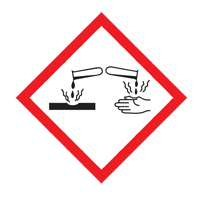
Do you know what the image above represents? I will give you a clue, it relates to lab safety. Any takers? Still nothing? Well, this my friends represents corrosive materials. This group includes many strong acids and bases and was a question I got wrong in my safety exam today (gasp, shock, you failed Tom). I know, I know, after 18 years of working in a lab, I still have issues with safety tests every once in a while. So why mention this. Well, I said a few months ago in a presentation, if I was going to celebrate my successes, I need to also discuss the times I failed. So this is my reason for telling the story, to say its OK to fail and to learn from it. But why am I taking a safety test in the first place.
Well every 3-4 years, when you work at McGill, they make us take a Workplace Hazardous Materials Information System (WHMIS) test to ensure we know safety regulations for working with hazardous materials, which in the lab is everything, even coffee. I passed WHMIS for the first time many years in 2007 and since then I could do the online refresher test every three years to remain certified. But, not this year. Oh no. Now its WHMIS 2015. New and improved. Which meant I had to sit through a 2h lecture all over again. So that was me Monday afternoon, sitting in a room Monday afternoon somewhere on McGill campus learning about the ten pictograms of hazardous materials, how to label a container, and in general how to act responsibly when working in a lab. Which after 17 years, I do pretty well at this, I might add (For any EHS inspectors reading).
Anyways, once you sign the attendance sheet, they send you the exam link which is also open book. And what did I do, I opened it this morning, and started answering away thinking I knew it all, hurrying through it and answering without thinking. And then BAM, results come in. Not good. It was almost as bad as the Iowa caucuses, although at least these results came within seconds and not days. 15 from 20 correct, and I needed 16 correct answers to pass. Stupid corrosive materials sent me astray. And to top things off, my student who started in lab did the test, and got 19, on her first attempt. Obviously she is great, but what a way to rub salts into the wound. Beaten by my own new graduate student.
I was stewing. Years and years of being in a lab, and I can’t pass a safety test. People now look at you different. Like “Hi Tom, so corrosive materials in your hands there, yeah you should put that down. You could hurt yourself“. The indignity of it all. So on it went, ridiculed by my colleagues. But, then light at the end of the tunnel, I got my retest link. Thank the lord, I got another shot at redemption, and this time boy do I do it right.
Multiple WHMIS manuals open, a large manual of SDS sheets for every chemical you could imagine and a banana to sustain me for the hour needed to complete the test. I will admit, it was this exam was a rocky road, corrosive vs flammable, is there a difference, well of course, but in the moment you question everything, fatigue sets in. 60 minutes pass and finally I finish. Then, the results come in. Booyah, I passed. 18 correct from 20, 90%, a passing grade, the clouds pass, and the sun shines again (obviously not in Montreal, we are peak winter and buried in snow, but I am sure somewhere else had sunshine, maybe San Diego). Corrosive materials are still my downfall, but now I know to never light a match around oxidizing materials, or the whole place goes up in smoke. Anyways, what a day in the lab life of Tom. The downs and ups. From being unsafe to being safety-approved. And now I can back to my hazardous job, sitting on a computer writing emails, living the scientist dream.
In some science news, I want to highlight great work from the ALS field from Dr. Christine Vande Velde, an exceptional ALS researcher in Montreal at the CHUM, hope you all please check it out. https://www.jbc.org/content/early/2020/02/06/jbc.RA119.011215.long
Next time, CRISPR editing will be discussed for all those editing aficionados.

Is that warning icon accurate? Asking for a friend.
For years I worked in Japan next to a cryostat that had a similar, but let’s just say more extreme version of the same graphic accompanied by the words “Warning: Cuts/Cuts off”.
Yes, based on my recent safety training I can its 90-95% correct. I would be interested in seeing this other graphic for comparison sake.